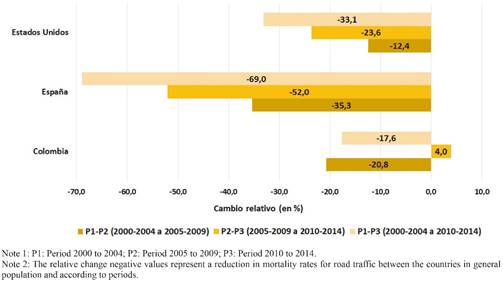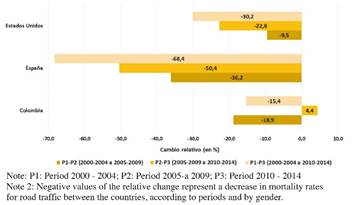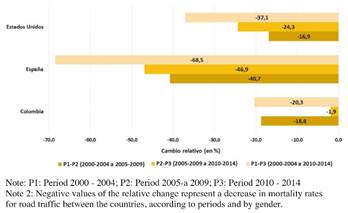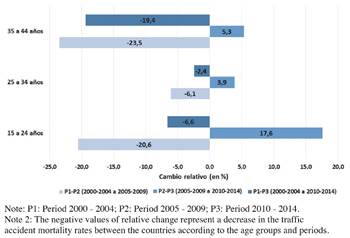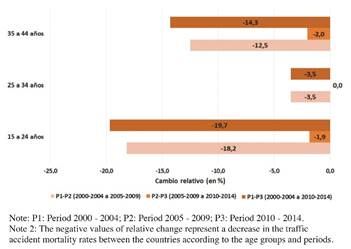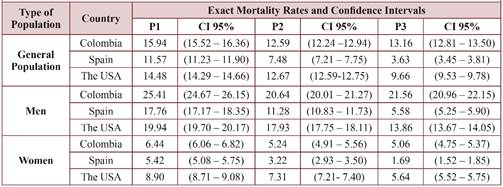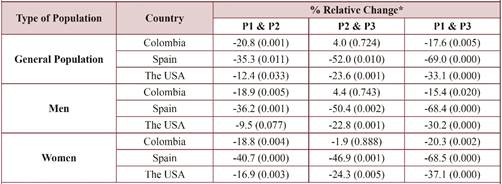ABSTRACT
Background:
Traffic accidents (TA) are a global problem with mortality of 1.25 million each year. The objective of this study was to compare adjusted mortality rates (AMR) by AT of Colombia, with Spain and the United States (US). The selection is justified because Colombia is a country with less development in road safety, Spain a nation that has adhered to European guidelines and US for having little adherence to international guidelines.
Methods:
A descriptive cross-sectional study was carried out for five-year periods, by calculating the AMRs by the direct method of standardization according to sex and age groups, as well as the adjustment of the motorization index. The mean values, the 95% confidence interval for each country and the relative change between the periods studied were calculated.
Results:
The AMR of periods P1 and P2 in all countries decreased significantly (p <0.005). In periods P2 and P3 also decreased significantly in Spain, by 52.0% (p = 0.010), and in the US, by 23.6% p = 0.001), while in Colombia the difference of 4.0% it was not significant (p = 0.724). Spain stood out for the reduction in mortality (P1-P3), by 69.0%.
Conclusions:
Colombia presented a less favorable evolution of mortality due to AT than Spain and the US. Men aged 15 to 44, motorcyclists and cyclists were the most committed. The TAs are a public health problem that Colombia has raised and must adapt to its reality those successful measures in other countries.
Key words:
Traffic accidents; Mortality; Comparative study
INTRODUCTION
Mortality from traffic accidents (TA) is a public health problem globally which leaves human losses estimated at 1.25 million each year, being persons aged between 15 to 44 years with the most mortality11. World Health Organization. Global status report on road safety 2015. WHO Library Cataloguing-in-Publication Data. 20 Avenue Appia. 1211 Geneva 27. Switzerland.2015, p. 1-340.,22. Instituto Nacional de Medicina Legal y Ciencias Forenses. Comportamiento de muertes y lesiones por accidentes de transporte. Colombia, 2015. Seguridad vial, un concepto que trasciende la educación vial. In: Forensis. Datos para la vida 2014. Bogotá: Instituto Nacional de Medicina Legal y Ciencias Forenses., 2015, p. 351-401.. Factors such as: inadequate speed; alcohol and drug consumption; failure to comply with the priority; tiredness or sleep; distraction33. Dobrynine E. Dirección General de Tráfico. Balance de Siniestralidad en España 2016. Notas de Prensa. Madrid. España.2017.; failure to keep distance between vehicles; not knowing how to drive properly or mechanical failures22. Instituto Nacional de Medicina Legal y Ciencias Forenses. Comportamiento de muertes y lesiones por accidentes de transporte. Colombia, 2015. Seguridad vial, un concepto que trasciende la educación vial. In: Forensis. Datos para la vida 2014. Bogotá: Instituto Nacional de Medicina Legal y Ciencias Forenses., 2015, p. 351-401.; among others, there are still fundamental factors in the TA genesis.
Half of the people who die for this cause all over the world are “vulnerable road users” i.e. pedestrians, cyclists and motorcyclists. If measures are not implemented to avoid this, it is expected that by 2030 the TAs will become the seventh leading cause of death worldwide11. World Health Organization. Global status report on road safety 2015. WHO Library Cataloguing-in-Publication Data. 20 Avenue Appia. 1211 Geneva 27. Switzerland.2015, p. 1-340.. Therefore, the decrease in accidents associated with traffic represents a challenge for public health worldwide11. World Health Organization. Global status report on road safety 2015. WHO Library Cataloguing-in-Publication Data. 20 Avenue Appia. 1211 Geneva 27. Switzerland.2015, p. 1-340..
The selection of these countries was done in the interest of comparing TA mortality in Colombia with countries, such as Spain which has for several years adhered to the principles of the European Union and with the United States of America (USA), a developed country, which has fallen behind in road safety, according to the Research Council on the National Transportation44. Morris M. Achieving Traffic Safety Goals in the United States: Lessons from Other Nations. Washington, D.C.: Transportation Research Board, 2011, p.1-262.. In addition, the three countries share a high coverage of their records of mortality55. United Nations. Coverage of Birth and Death Registration. New York: United Nations Statistics Division, 2014. (90% Colombia, Spain and the United States with 100%), which guarantees a good comparability between them. For the first five years, of the XXI century Spain, presented an AMR of 11.6 per 100 000 inhabitants, while the United States showed 14.5 per 100 000 inhabitants and Colombia had 15.9 per 100 000 inhabitants in a country where the traffic accidents (TA) constitute a major social and public health problem placing it as the second cause of violent death after homicides in the year 201522. Instituto Nacional de Medicina Legal y Ciencias Forenses. Comportamiento de muertes y lesiones por accidentes de transporte. Colombia, 2015. Seguridad vial, un concepto que trasciende la educación vial. In: Forensis. Datos para la vida 2014. Bogotá: Instituto Nacional de Medicina Legal y Ciencias Forenses., 2015, p. 351-401..
The deaths from TAs represent 2.5 % of the Gross National Product of the expenses in health and it is foreseen, being based on the projections for 2020 from the motorization index that the mortality in Colombia will increase especially in the users of motorbikes66. Instituto Nacional de Medicina Legal. Accidentes de motociclistas, hacia la identificación de medidas efectivas. Forensis. Bogotá, Colombia: Instituto Nacional de Medicina Legal, 2010, p. 1-60.. It is relevant to bear in mind close to half of the victims are young people77. Ferrer A, Smith R, Espinosa O, Cuellar M and Raffo V. Análisis de la capacidad de gestión de la Seguridad Vial en Colombia. Fondo Mundial para Seguridad Vial-Global Road Safety Facility Bogotá: World Bank LAC. 2013: 1-256.. According to the World Bank, a person at the wheel, in Colombia, has 4 times more probabilities of dying in a traffic accident than does a driver in Spain or Great Britain88. Kopp A, Block RI and Iimi A. Avances en la dirección correcta. Promoción de un sector de transporte con bajas emisiones de carbono para asegurar el desarrollo. Serie Directions in Develoment: Medio ambiente y desarrollo sostenible. Banco Mundial, 2013, p. 1-22.. So, Colombia is one of the 68 countries that presents with increases in the traffic accident deaths since 2010, removing the country increasingly away from the goal of “The Decade of Action for Road Safety 2011-2020”22. Instituto Nacional de Medicina Legal y Ciencias Forenses. Comportamiento de muertes y lesiones por accidentes de transporte. Colombia, 2015. Seguridad vial, un concepto que trasciende la educación vial. In: Forensis. Datos para la vida 2014. Bogotá: Instituto Nacional de Medicina Legal y Ciencias Forenses., 2015, p. 351-401..
Our hypothesis is that the countries with a better implementation of strategies of road safety have major reductions in their mortality. The target of this study was to compare the TA mortality in Colombia between the years 2000 to 2014 with that of Spain and the USA.
SUBJECTS AND METHODS
There was a descriptive study of a cross section of the TA mortality for three countries: Colombia, Spain and the USA corresponding to the quinquenniums P1=2000-2004, P2=2005-2009, P3=2010-2014. The information about the population and the deaths for TA that happened in the period 2000-2014 came from the following official sources from every country: Colombia, from the National Institute of Legal Medicine and Forensic Sciences (www.medicinalegal.gov.co/) and the Road Prevention Fund (www.fpv.org.co/); Spain, from the General Direction of Traffic “DGT” (www.dgt.es/) and of the Statistical Yearbook published for the National Institute of Statistics of Spain “INE” (www.ine.es/prodyser/pubweb/anuarios_mnu.htm) and in the USA by the Fatality Analysis Reporting System, FARS (NHTSA) (www.nhtsa.gov/). The mortality rate (MR) of the three countries was calculated based on the mortality reports from 30 days after the accident99. United Nations. Convention of Road Traffic Vienna: Economic Commission for Europe. Inland Transport Committee, 2012, p. 66.. Two indicators of exhibition were also obtained from the traffic accidents: 1) the motorization index and the vehicle parking lot. The motorization Index was defined as the number of vehicles motorized by inhabitant in a place and at a given period1010. Gartner A. Estudio sobre tasa de motorización. Relaciones y determinantes. In: Secretaría de Extensión Universitaria. Universidad Tecnológica n, (ed.). Av. Mitre 750 - CP. 1870 4201-4133 Int. 124. Avellaneda. Argentina.: Centro Tecnológico del transporte, tránsito y seguridad vial, 2011, p. 1-22..
From the obtained information of the previous sources a calculation was made of the exact adjusted mortality rates (AMR) in which the direct method of standardization of mortality rates in Colombia, Spain and the USA were adjusted for the general population and by sex, according to the world population standard in 2007 (half of the period of study) obtained from the United Census Bureau of the Department of Commerce of the USA (U.S. Department of Commerce 2015). Later the adjustments were standardized according to sex and age groups given by module of Rate Adjustment from the statistical Software EPIDAT 4.1 of Xunta de Galicia-OPS1111. Conselleria de Sanidad O, Universidad CES, Xunta de Galicia España. Epidat: Programa para análisis epidemiológico de Datos. 4.1 ed. San Lázaro, s/n 15703, Santiago de Compostela. A Coruña. 2014.. Also a rate adjustment was made according to the scrap yard/parking lot from every country; a calculation was made regarding the reason for the TA mortality based on the number of vehicles registered by every country (it was named the TA motorization mortality rate), formulated by means of the TA mortality rate for 100,000 inhabitants over the motorization index for 100 000 inhabitants, in such a way that the population remained considered for both calculations.
The average values were calculated for every quinquennium, as well as for the confidence interval of 95 % (IC95 %), of the AMR from every country. For the different age groups the specific rate was calculated for each one of them by country. The percentage rate was analyzed by means of the relative change calculation of the adjusted and specific rates among the three quinquenniums studied, P1, P2 and P3: % Relative Change (RC) = (Pf-Pi)/Pi x 100 where Pf is the final period and Pi is the initial period in the comparison. The significant differences were established (p <0.05) in the three compared periods (P1 vs. P2, P2 vs. P3 and P1 vs. P3) using post hoc Tukey range tests in ANOVA. The brute TA mortality rates for the three countries were proportioned based on public route users (pedestrians, motorcyclists and cyclists) since the primary information from every country was not available the adjusted mortality rate (AMR) was not possible to obtain. This analysis was realized by the statistical packet IBM-SPSS (V23.0).
RESULTS
An observance was made about the periods P1-P2 in the three countries that the AMR had diminished significantly: in Colombia (20.8%); in Spain (35.3%) and in the USA (12.4%); (p=0.001; p=0.011; p=0.033 respectively) (tables 1 and 2, figure 1); equally the decrease was significant in the three countries when they were compared globally for the periods P1-P3 (p<0.05). Nevertheless, in the period P2-P3, Colombia experienced an increase in its AMR by 4 %, which contrasted with the reduction of the 52 % that Spain experienced and of 23.6 % that the USA experienced in the same period (figure 1).
Exact traffic accident mortality rates according to general population and sex for Colombia, Spain and the United States. Periods: P1=2000-2004, P2=2005-2009 and P3=2010-2014
Comparison of relative change in the adjusted mortality rates for traffic accidents in the general population in Colombia, Spain and the United States for the periods: 2000-2004, 2005-2009 & 2010-2014
In the comparison for genre, the AMR for men experienced a significant decrease in periods P1-P2: Colombia with 18.9%; Spain with 36.2% and the USA with 9.5%. In the period P1-P3 the global AMR decrease in Spain was 68.4% which passed from 11.6 to 3.6 for each 100,000 inhabitants (p=0.000) (Table 1, Table 2 and Figure 2a) whereas in the USA the reduction was 0.2% and in Colombia it was 15.4%. Nevertheless, in the period P2-P3 the reduction that was observed in Spain and the USA (50.4 % and 22.8 %, respectively) contrasted with the increase of 4.4 % in Colombia (tables 1 and 2, figure 2a).
Comparison of relative changes in exact adjusted traffic accident mortality rates in men in Colombia, Spain and the United States. Períods 2000-2004, 2005-2009 & 2010-2014
For the women, the comparison between the periods P1-P2 showed a significant reduction of the AMR: Spain reduced by 40.7 %; followed by Colombia with 18.8 % and the USA with 16.9 % (Table 1, Table 2 and Figure 2b). In the comparison for the periods P1-P3, the three countries significantly reduced their AMR but Spain stood out with the highest reduction rate at 68.5 %, and passed from 5.4 to 1.7 per 100 000 inhabitants (p=0.000). In the period P2-P3, the three countries reduced their AMR although the proportions were very distinct: Spain with 49.9%; The USA with 24.3% and Colombia in scarcely 1.9%.
Comparison of realitve changes in exact adjusted traffic accident mortality rates in women in Colombia, Spain and the United States. Períods 2000-2004, 2005-2009 & 2010-2014
The AMR diminished significantly in the three countries and in all the age groups in the periods P1-P2 (p <0.05), except in the group from 25 to 34 years in Colombia, which only diminished 5.9 % and from 18.8 to 17.7 per 100 000 inhabitants (p=0.654), and in the USA, which diminished 5.2 % (from 17.3 to 16.4; p=0.452) (tables 3 and 4). Between the periods P1-P3 the AMR had decreased all the countries and in all age groups with significant differences (p=0.005), except in the group from 15 to 24 years in Colombia, which diminished by only 8.3 %, from 16.9 to 15.5 per 100 000 inhabitants (p=0.420) and in the group from 25 to 34 years of age where the AMR increased by 0.5 %, passing from 18.8 to 18.9 (p=0.996). This minor mortality reduction in Colombia is due to the fact that in the period P2-P3 it had produced an increase in the AMR in both age groups, it was 18.3 % in that of 15 to 24 years and 6.8 % in that group from 25 to 34 years (figure 2a and 2b).
Adjusted mortality rates for traffic accidents according to age groups in Colombia, Spain and the United States. Periods: P1=2000-2004, P2=2005-2009 and P3=2010-2014
When the groups were compared by age genre quite different results were obtained for the men and the women and according to the age group. Both in Spain and in the USA a reduction of the AMR was demonstrated in all the groups for both sexes in all the periods. In Colombia, on the other hand, for the men aged from 15 to 24 years, from 25 to 34 years and from 25 to 34 years there was a significant increase in the period P2-P3 (table 5, figure 3a) of the 18.3 %, 6.8 % and 7.6 %, respectively. For the women in the same age groups in Colombia, there were no increases however they presented a reduction or stabilization in their AMR (table 4, figure 3b).
Brute mortality rate (for 100,000 inhabitants) for traffic accidents and relative change percentage for pedistrians, motorcyclists and ciclysts in Colombia, Spain and the United States. Period 2000-2014
Comparison of relative change in the adjusted mortality rates for traffic accidents in Colombia according to men aged: 15 - 24, 25 - 34 & 35 - 44 years in the periods: 2000-2004, 2005-2009 & 2010-2014
Comparison of relative change in the adjusted mortality rates for traffic accidents in Colombia according to women aged: 15 - 24, 25 - 34 & 35 - 44 years in the periods: 2000-2004, 2005-2009 & 2010-2014
As for the motorization index, in the period P1-P3 Colombia showed an increase of 243.1%, (passing from 70 to 240.2 for 1.000 inhabitants) which was much more than in Spain and the USA, whereas Spain increased 13,1% (from 573.7 to 648.9 for 1.000 inhabitants) and in the USA 12.7 %. (from 772 to 870.7 for 1.000 inhabitants). The AMR, in Colombia, according to the motorization index showed 182, 96 and 56 deaths for every 100.000 vehicles in the periods 1, 2 and 3 respectively; these rates for the USA were 18, 15 and 11, whereas for Spain, they were 19, 11 and 5 in the same respective periods.
On having analyzed the brute mortality rate (BMR) of every country, for public route users, in the period 2000-2014, Spain showed an outstanding reduction of 68.2 % in pedestrian mortality passing from 2.2 to 0.7 per 100.000 inhabitants and Colombia followed with a reduction of 44.8 %, passing from 6.7 to 3.7. As for motorcyclists, Spain equally showed a mortality reduction of 19.0 % and a rate variation from 2.1 to 1.7. On the other hand, Colombia and the USA showed increased mortality: The USA increased by 40% (from 1.0 to 1.4 per 100 000) and Colombia increased by 38.9 % (from 3.6 to 5.0). Among the cyclists, Spain and the USA did not present changes in the same period (0.2 per 100 000 inhabitants) whereas Colombia emphasized a mortality increase of 133.3 %, passing from 0.3 to 0.7 per 100 000 inhabitants (table 6).
DISCUSSION
The results of this study demonstrate that three countries presented with an evolution that clearly differentiated their TA mortality rates. The results from Spain proved to be outstanding by presenting with the highest global reduction. The decrease is observed in every quinquennium, in both sexes and for all the age groups. The USA equally presents an important reduction, also with decreases from period to period, in both sexes and for all the age groups although during the first period the reduction among the men was not significant not either in the group of 25 to 34 years.
Therefore, the obtained results are really worrying so whereas the mortality for traffic accidents diminishes in a progressive way in countries such as Spain and the USA, in Colombia, after some promising information at the beginning of the century, the final information is quite negative. In effect, instead of continuing with a decreasing tendency, parallel to that of the other two countries, Colombia showed an increase in the mortality rate among the young men and more specifically still, in the age group from 15 to 24 years where the young men are eligible for driving. These results coincide with similar studies conducted by the European Union, the OMS, the OPS, the World Bank and the Inter-American Development Bank1212. World Organization Health. Global status report on road safety 2013: supporting a decade of action. Ginebra; Suiza 2013, p. 1-318.,1313. Organización Mundial de la Salud. Lesiones causadas por el tránsito. In: prensa Cd, (ed.). OMS, 2015, p. 1-16.,1414. Organización Panamericana de la Salud. Defunciones por accidentes de tránsito en países seleccionados de las Américas, 1985-2001. Boletin Epidemiológico. 2004; 25: 2-5.,1515. Organización Panamericana de Salud. Redes Integradas de Servicios de Salud: Conceptos, opciones de política y hoja de ruta para su implementación en las Américas. In: OPS, (ed.). Washington D.C. 2010, p. 1-102.,1616. Banco Interamericano de Desarrollo. Estrategia de Seguridad Vial. Cerrando la brecha de siniestralidad en América Latina y el Caribe. Plan de Acción 2010 - 2015. 1300 New York Avenue, N.W. Washington, D.C. 20577, USA. 2012, p. 1-16. and in Colombia, with the studies of different institutions that have identified this situation as a serious public health problem22. Instituto Nacional de Medicina Legal y Ciencias Forenses. Comportamiento de muertes y lesiones por accidentes de transporte. Colombia, 2015. Seguridad vial, un concepto que trasciende la educación vial. In: Forensis. Datos para la vida 2014. Bogotá: Instituto Nacional de Medicina Legal y Ciencias Forenses., 2015, p. 351-401.,77. Ferrer A, Smith R, Espinosa O, Cuellar M and Raffo V. Análisis de la capacidad de gestión de la Seguridad Vial en Colombia. Fondo Mundial para Seguridad Vial-Global Road Safety Facility Bogotá: World Bank LAC. 2013: 1-256..
The unequal or negative evolution of traffic accident mortality in Colombia, in the latest analyzed period, maintains a direct relationship with the progressive and major motorization indexes of the country. When the mortality rates are adjusted, it can be observed that the mortality in Colombia is still higher than that of Spain and the USA. It is very alarming to see that motorcycles in Colombia have become a third part of the motorized park/scrapyard in the year 2000 to constitute more than half in 20141717. Ministerio de Transporte. Anuario Estadístico Transporte en Cifras - Estadísticas 2015 Bogotá, Colombia: Ministerio de Transporte, 2015, p. 1-100.. That would explain the increased mortality involving motorcycle and bicycle users, at 38.9 % and 133.3 %, respectively. In the USA an important mortality increase also took place (40%) among motorcycle users, whereas, in Spain the evolution was positive for all the types of users; on the other hand in Colombia a reduction of the mortality was observed among the pedestrians (-44.8 %) between the years 2000 and 2014.
The results of this study demonstrate evidence that is necessary and urgent to adopt measurements, in Colombia, that is rapidly effective for reverting the final negative tendencies of traffic accident mortality. According to our information, it is clear that the priority must be to reduce the traffic accidents among the young men who are bicycle and motorcycle users. For this reason strategies must be adopted that allow for improvement in designing routes and to offer road education instruction. Also to implement the civil culture and it can be very useful to bear in mind and to adapt to the local reality based on experiences from successful countries such as Spain1313. Organización Mundial de la Salud. Lesiones causadas por el tránsito. In: prensa Cd, (ed.). OMS, 2015, p. 1-16.,1818. World Organization Health. European status report on road safety: towards safer roads and healthier transport choices. Copenhagen: WHO Regional Office for Europe, 2009, p. 1-179.,1919. Borsos A, Koren C, Egyetem Z and Ravishanker N. Long-term safety trends related to vehicle ownership in 26 countries. In: Attila B, (ed.). 2010-2011. The Fulbright Grantee, 2012, p. 1-10..
The fortitude of this study emphasizes the comparable approach of data analysis and rigor applied in the utilization of standardized methods. For the potential limitations, it is necessary to point out the difficulty for studying more disintegrated age groups77. Ferrer A, Smith R, Espinosa O, Cuellar M and Raffo V. Análisis de la capacidad de gestión de la Seguridad Vial en Colombia. Fondo Mundial para Seguridad Vial-Global Road Safety Facility Bogotá: World Bank LAC. 2013: 1-256.,2020. Organización Panamericana de la Salud. Informe sobre el Estado de la Seguridad Vial en la Región de las Américas 2009. Washington, D.C. 2009, p. 1-108. and the limited number of investigative studies in road safety existing in Colombia, that might have contributed new information to study the analysis of the TA mortality more extensively1212. World Organization Health. Global status report on road safety 2013: supporting a decade of action. Ginebra; Suiza 2013, p. 1-318.,2121. Borse NN and Hyder AA. Call for more research on injury from the developing world: results of a bibliometric analysis. Indian J Med Res. 2009; 129: 321-6.,2222. Huang CM, Lunnen JC, Miranda JJ and Hyder AA. Road traffic injuries in developing countries: research and action agenda. Rev Peru Med Exp Salud Publica. 2010; 27: 243-7.. Likewise, the fact of being a cross-sectional study prevents establishing causal associations between mortality and its possible determinants.
In conclusion, a less favorable evolution of the mortality is observed for traffic accidents in Colombia than in Spain and the USA, since it presents higher mortality rates in all the age groups and in every period. The initially positive evolution stagnated in the years 2010-2014, fundamentally at the cost of an increase of the mortality in Colombian men aged from 15 to 44 years. The motorcyclists and the cyclists are the most compromised public route users. Therefore, it is necessary to recognize traffic accidents as being one of the principal public health problems posed in Colombia and to adapt this reality to measurements that have been successful in other countries.
ACKNOWLEDGEMENTS
The authors are grateful to Hugo Hurtado, Jesús David Falla y Llercy E. Ome for the support in the information process; to the University Surcolombiana and to The Cochrane Database of Systematic Reviews (CDSR) (Center Cochrane Iberoamericano) for its support. José Domingo Alarcón is a candidate for a Doctorate in Public Health and Biomedical Investigation Methodology in the Department of Paediatrics, Midwifery, Gynecology and Preventive Medicine at the Universitat Autònoma in Barcelona, Spain.
References
- 1World Health Organization. Global status report on road safety 2015. WHO Library Cataloguing-in-Publication Data. 20 Avenue Appia. 1211 Geneva 27. Switzerland.2015, p. 1-340.
- 2Instituto Nacional de Medicina Legal y Ciencias Forenses. Comportamiento de muertes y lesiones por accidentes de transporte. Colombia, 2015. Seguridad vial, un concepto que trasciende la educación vial. In: Forensis. Datos para la vida 2014. Bogotá: Instituto Nacional de Medicina Legal y Ciencias Forenses., 2015, p. 351-401.
- 3Dobrynine E. Dirección General de Tráfico. Balance de Siniestralidad en España 2016. Notas de Prensa. Madrid. España.2017.
- 4Morris M. Achieving Traffic Safety Goals in the United States: Lessons from Other Nations. Washington, D.C.: Transportation Research Board, 2011, p.1-262.
- 5United Nations. Coverage of Birth and Death Registration. New York: United Nations Statistics Division, 2014.
- 6Instituto Nacional de Medicina Legal. Accidentes de motociclistas, hacia la identificación de medidas efectivas. Forensis. Bogotá, Colombia: Instituto Nacional de Medicina Legal, 2010, p. 1-60.
- 7Ferrer A, Smith R, Espinosa O, Cuellar M and Raffo V. Análisis de la capacidad de gestión de la Seguridad Vial en Colombia. Fondo Mundial para Seguridad Vial-Global Road Safety Facility Bogotá: World Bank LAC. 2013: 1-256.
- 8Kopp A, Block RI and Iimi A. Avances en la dirección correcta. Promoción de un sector de transporte con bajas emisiones de carbono para asegurar el desarrollo. Serie Directions in Develoment: Medio ambiente y desarrollo sostenible. Banco Mundial, 2013, p. 1-22.
- 9United Nations. Convention of Road Traffic Vienna: Economic Commission for Europe. Inland Transport Committee, 2012, p. 66.
- 10Gartner A. Estudio sobre tasa de motorización. Relaciones y determinantes. In: Secretaría de Extensión Universitaria. Universidad Tecnológica n, (ed.). Av. Mitre 750 - CP. 1870 4201-4133 Int. 124. Avellaneda. Argentina.: Centro Tecnológico del transporte, tránsito y seguridad vial, 2011, p. 1-22.
- 11Conselleria de Sanidad O, Universidad CES, Xunta de Galicia España. Epidat: Programa para análisis epidemiológico de Datos. 4.1 ed. San Lázaro, s/n 15703, Santiago de Compostela. A Coruña. 2014.
- 12World Organization Health. Global status report on road safety 2013: supporting a decade of action. Ginebra; Suiza 2013, p. 1-318.
- 13Organización Mundial de la Salud. Lesiones causadas por el tránsito. In: prensa Cd, (ed.). OMS, 2015, p. 1-16.
- 14Organización Panamericana de la Salud. Defunciones por accidentes de tránsito en países seleccionados de las Américas, 1985-2001. Boletin Epidemiológico. 2004; 25: 2-5.
- 15Organización Panamericana de Salud. Redes Integradas de Servicios de Salud: Conceptos, opciones de política y hoja de ruta para su implementación en las Américas. In: OPS, (ed.). Washington D.C. 2010, p. 1-102.
- 16Banco Interamericano de Desarrollo. Estrategia de Seguridad Vial. Cerrando la brecha de siniestralidad en América Latina y el Caribe. Plan de Acción 2010 - 2015. 1300 New York Avenue, N.W. Washington, D.C. 20577, USA. 2012, p. 1-16.
- 17Ministerio de Transporte. Anuario Estadístico Transporte en Cifras - Estadísticas 2015 Bogotá, Colombia: Ministerio de Transporte, 2015, p. 1-100.
- 18World Organization Health. European status report on road safety: towards safer roads and healthier transport choices. Copenhagen: WHO Regional Office for Europe, 2009, p. 1-179.
- 19Borsos A, Koren C, Egyetem Z and Ravishanker N. Long-term safety trends related to vehicle ownership in 26 countries. In: Attila B, (ed.). 2010-2011. The Fulbright Grantee, 2012, p. 1-10.
- 20Organización Panamericana de la Salud. Informe sobre el Estado de la Seguridad Vial en la Región de las Américas 2009. Washington, D.C. 2009, p. 1-108.
- 21Borse NN and Hyder AA. Call for more research on injury from the developing world: results of a bibliometric analysis. Indian J Med Res. 2009; 129: 321-6.
- 22Huang CM, Lunnen JC, Miranda JJ and Hyder AA. Road traffic injuries in developing countries: research and action agenda. Rev Peru Med Exp Salud Publica. 2010; 27: 243-7.
Sugested citation:
Alarcón JD, Gich Saladich I, Vallejo Cuellar L, Ríos Ga llardo AM, Montalvo Arce C, Bonfill Cosp X. Mortality caused by traffic accidents in Colombia. Comparison with other countries. Rev Esp Salud Pública.2018;92: July 5 e201807040.
Publication Dates
- Publication in this collection
26 Oct 2020 - Date of issue
2018
History
- Received
09 Aug 2017 - Accepted
25 June 2018


